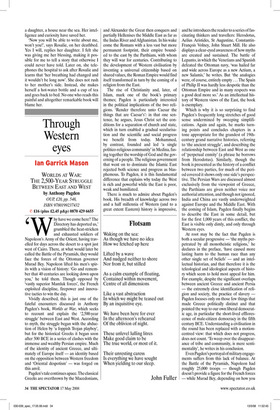Through Western eyes
Ian Garrick Mason
WORLDS AT WAR: THE 2,500-YEAR STRUGGLE BETWEEN EAST AND WEST by Anthony Pagden OUP, £20, pp. 548, ISBN 9780199237432 ✆ £16 (plus £2.45 p&p) 0870 429 6655 and exhausted soldiers of Napoleon’s Army of the Orient, having travelled for days across the desert to a spot just west of Cairo. There, at what would later be called the Battle of the Pyramids, they would face the forces of the Ottoman governor Murad Bey. Napoleon lifted his men’s spirits with a vision of history: ‘Go and remember that 40 centuries are looking down upon you,’ he told them. Though opposed by ‘vastly superior Mamluk forces’, the French exploited discipline, firepower and innovative tactics to win the day.
Vividly described, this is just one of the fateful encounters discussed in Anthony Pagden’s book, Worlds at War, which seeks to recount and explain the ‘2,500-year struggle’ between East and West. According to myth, the struggle began with the abduction of Helen by ‘a foppish Trojan playboy’, but for the historical Greeks it began soon after 500 BCE in a series of clashes with the immense and wealthy Persian empire. Much of the identity of ancient Greece, and ultimately of Europe itself — an identity based on the opposition between Western freedom and ‘Oriental despotism’ — was forged on this anvil.
Pagden’s tale continues apace. The classical Greeks are overthrown by the Macedonians, and Alexander the Great then conquers and partially Hellenises the Middle East as far as the Indus River and Afghanistan. In his wake come the Romans with a less vast but more permanent footprint, their empire bounded to the east by the Parthians, with whom they will war for centuries. Contributing to the development of Western civilisation by inventing a universal citizenship based on shared values, the Roman Empire would find itself transformed in turn by the coming of a religion from the East.
The rise of Christianity and, later, of Islam, mark one of the book’s primary themes; Pagden is particularly interested in the political implications of the two religions. ‘Render therefore unto Caesar the things that are Caesar’s’: in that one sentence, he argues, Jesus Christ set the conditions for a separation of church and state, which in turn enabled a gradual secularisation and the scientific and social progress we benefit from today. Mohammed, by contrast, founded and led ‘a single politico-religious community’ in Medina, fusing together the worship of God and the governing of a people. The religious government that went on to dominate the Islamic East rejected both science and progress as blasphemous. To Pagden, it is this fundamental difference that explains why today the West is rich and powerful while the East is poor, weak and humiliated.
There is much to admire about Pagden’s book. His breadth of knowledge across two and a half millennia of Western (and to a great extent Eastern) history is impressive, and he introduces the reader to a series of fascinating thinkers and travellers: Herodotus, Aelius Aristides, St Augustine, ConstantinFrançois Volney, John Stuart Mill. He also displays a clear-eyed awareness of how myths are created and sustained. The battle of Lepanto, in which the Venetians and Spanish defeated the Ottoman navy, ‘was hailed far and wide across Europe as a new Actium, a new Salamis,’ he writes. But ‘the analogies were, of course, entirely empty . . . The Spain of Philip II was hardly less despotic than the Ottoman Empire and in many respects was a good deal more so.’ As an intellectual history of Western views of the East, the book is exemplary.
Which is why it is so surprising to find Pagden’s frequently long stretches of good sense undermined by sweeping simplifications. Again and again, he marks turning points and concludes chapters in a tone appropriate for the grandest of 19thcentury grand narrative histories, referring to ‘the ancient struggle’, and describing the relationship between East and West as one of ‘perpetual enmity’ (a phrase he borrows from Herodotus). Similarly, though the book is presented as the history of a conflict between two parties, for much of the period covered it shows only one side’s perspective. The Persian Wars are discussed almost exclusively from the viewpoint of Greece, the Parthians are given neither voice nor authorial attention, and though not ignored, India and China are vastly underweighted against Europe and the Middle East. With the coming of Islam, Pagden finally begins to describe the East in some detail, but for the first 1,000 years of this conflict, the East is visible only dimly, and only through Western eyes.
At root may be the fact that Pagden is both a secular progressive — ‘the myths perpetrated by all monotheistic religions,’ he declares in the preface, ‘have caused more lasting harm to the human race than any other single set of beliefs’ — and an intellectual historian, and that therefore it is the teleological and ideological aspects of history which seem to hold most appeal for him. For example, despite the significant overlaps between ancient Greece and ancient Persia — the extremely close identification of religion and society, the practice of slavery — Pagden focuses only on those few things that made Greece politically distinct and that pointed the way to our own liberal democratic age, in particular the short-lived efflorescence of male-citizen democracy in the fifth century BCE. Understanding a civilisation in the round has been replaced with a motioncentred view: that which does not progress, does not count. ‘To weep over the disappearance of tribe and community, is mere sentimentality’, he writes in his conclusion.
Even Pagden’s portrayal of military engagements suffers from this lack of balance. At the Battle of the Pyramids, Napoleon had roughly 25,000 troops — though Pagden doesn’t provide a figure for the French forces — while Murad Bey, depending on how you










































































 Previous page
Previous page